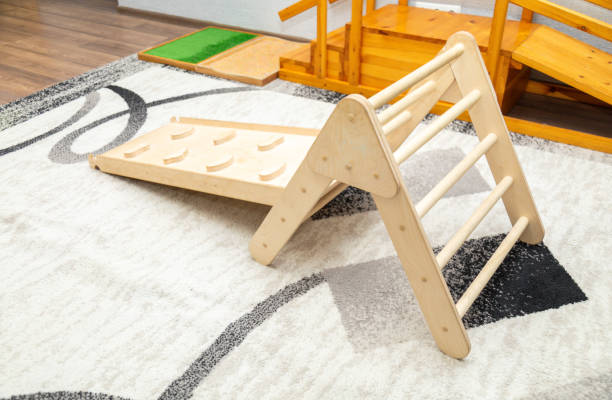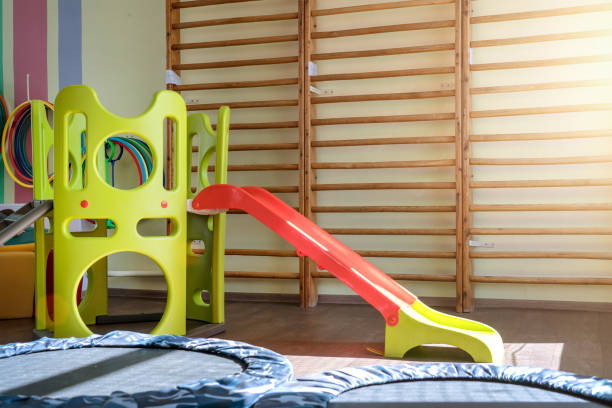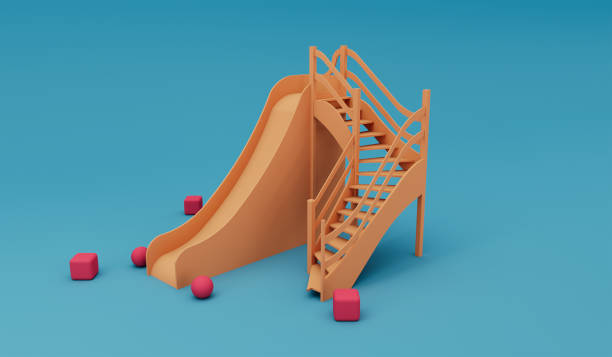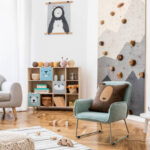The Power of the Montessori Slide Educational Framework – Beyond the Game
The Montessori Slides Method, pioneered by Dr. Maria Montessori in the early 20th century, is a child-centered educational approach that emphasizes independence, hands-on learning, and self-directed activity. At its core, it encourages children to explore their surroundings at their own pace and develop a love of learning through purposeful play.Montessori climbing toys, such as Montessori jungle gyms, climbing gyms, Pikler triangles, ladders, and Montessori Slides.The Montessori method embodies these principles by providing safe, fun tools that help children develop physically, cognitively, and emotionally. Among them, Montessori slides and supporting tools such as Montessori climbing frames, Pickler tripods, and Montessori ladders are more than just toys, they are tools.
Rooted in Montessori’s philosophy of autonomy, physical, and cognitive development, these indoor climbing structures are often misunderstood as basic playground equipment. But when designed and applied correctly, they become indispensable learning tools that help children of all developmental stages and learning abilities. Let’s explore how Montessori slides and supporting climbing tools are both universally inclusive, intellectually enriching, and safely integrated into a variety of educational settings, making them inclusive for all children. It also explores the practical issues of how educators and parents can adapt these tools to the Montessori method, and explores the importance of templates and modular structures in the modern Montessori classroom.
Developmental Benefits Of Climbing Toys: Functional Design Meets Developmental Goals
Climbing is in the nature of children, driven by their curiosity and desire to explore. Research has highlighted several key benefits of climbing activities that are amplified when combined with Montessori climbing toys: the Montessori Jungle Gym introduces elements of freedom, challenge and problem solving. Unlike traditional metal or plastic play facilities in public parks, Montessori indoor gyms emphasize organic movement in a controlled environment. They are usually made of natural wood, ergonomic and modular.
- Physical Development: Climbing engages large muscle groups, strengthening core, upper body, and leg muscles. It also enhances balance, coordination, and proprioception—the sense of where one’s body is in space. A study by PlayCore found that climbing at a young age improves spatial and directional awareness, as well as physical skills like hand-foot coordination and agility . These activities also support healthy bone growth and cardiovascular health, contributing to a physically active lifestyle.
- Cognitive Development: Navigating climbing structures requires children to plan their movements, estimate distances, and solve problems. For example, deciding where to place a foot on a Montessori ladder or how to slide down a Montessori slide fosters critical thinking and spatial awareness. These cognitive challenges align with the Montessori emphasis on experiential learning.
- Emotional and Social Growth: Overcoming obstacles, such as reaching the top of a Montessori Pikler triangle, builds confidence and resilience. Climbing with peers encourages cooperation and communication, fostering social skills. These emotional and social benefits are particularly valuable in Montessori settings, where children learn to interact respectfully in a community.
Developmental Benefits Backed by Research
A study published in Early Childhood Development and Care in 2021 noted that young children who used climbing tools such as Pickler’s Triangles improved their spatial reasoning by 30% after six weeks of unstructured play. These benefits make climbing toys, including slides, an important tool in the development of the whole child, not unlike the Montessori philosophy.

Montessori Uses The Principles Of Climbing Toys
Montessori climbing toys are designed to follow specific principles:Universal Design Principles-Accommodate children of all motor skill levels. Accommodating Neurodiverse Learners – can be paired with weighted climbing blankets, tactile handrails, or soothing slides rails to support students with autism or sensory processing disorders. Reflects the approach’s focus on child-led learning:
- Child-Sized Design: Equipment like Montessori jungle gyms and climbing gyms is scaled to fit young children, allowing them to engage independently without adult intervention. This fosters a sense of autonomy and self-confidence.
- Natural Materials: Most Montessori climbing toys are crafted from wood, which is durable, safe, and aesthetically pleasing. These materials connect children to the natural world, a key aspect of Montessori education.
- Versatility and Open-Ended Play: Toys like the Montessori Pikler triangle can be used in multiple ways—climbing, sliding, or even as a fort—encouraging imaginative play and creativity. This versatility supports the Montessori principle of allowing children to explore at their own pace.
By following these principles, Montessori climbing toys create an environment where children can develop skills through independent exploration. Children are encouraged to explore independently and develop their risk assessment and balance skills from an early age.
Designing Inclusive Montessori Slides – For All Students
To ensure that Montessori slides are appropriate for all children, including those with different physical or developmental needs, designers must prioritize inclusivity. Inclusion is key to accommodating neurodiverse learners. Below are key considerations for designing inclusive slides:
Universal Design Principles
- Adjustable Heights: Adjustable height slides can accommodate children of different ages and motor skill levels. For example, a lower height is suitable for young children, while a higher height is suitable for older children. This adaptability ensures that the slide remains appropriate as children grow.
- Non-Slip Surfaces: Safety is critical, especially for children with balance or sensory challenges. Non-slip surfaces on the slide and its platforms reduce the risk of accidents and make the equipment easy for everyone to use.
- Gentle Slopes: Gentle slopes are more conducive to children with limited mobility, ensuring they can enjoy the slide without feeling overwhelmed.
- Safety Features: Install sturdy handrails or handles on the slide to provide support for children who need help. These slides should be ergonomically designed for small hands and placed at a convenient height.
- Multiple Access Points: Slides come with ladders and ramps or bumpers to facilitate access for children of varying mobility abilities.
Custom Templates:Why Montessori Schools Need Templates
Templates are essential to ensure consistency and safety of Montessori climbing toys in different settings. Templates are essential for structures such as slides or climbing tripods:
- Standardized Design: Templates ensure that equipment like Montessori jungle gyms and slides meets safety and quality standards, regardless of where they are used.
- Easier training for educators
- Customization for student groups
- Safety and Maintenance: Templates provide guidelines for assembling, using, and maintaining climbing toys, reducing the risk of accidents and ensuring longevity.
- Reproducibility
- Safety consistency
- Scalability: As Montessori schools expand, templates allow them to replicate successful play environments, maintaining the integrity of the Montessori approach.
By using templates, Montessori schools and families can create safe, consistent and effective play spaces that support children’s growth. Templates also offer affordable DIY options to promote equitable access. These design elements align with universal design principles, ensuring Montessori slides are inclusive and beneficial for all children. By creating a safe and convenient play environment, these slides promote physical activity and confidence in every child.
Key Features for Inclusive Montessori Slides
| Feature | Benefit | Example Application |
|---|---|---|
| Adjustable Heights | Accommodates different ages and abilities | Slide height adjustable from 2 to 4 feet |
| Non-Slip Surfaces | Enhances safety for all users | Textured slide surface |
| Gentle Slope | Accessible for children with mobility issues | 30-degree incline |
| Safety Rails | Provides support for balance | Ergonomic handrails on both sides |
| Multiple Access Points | Ensures access for diverse mobility levels | Ladder and ramp options |
Choosing the Right Montessori Climbing Gym: Exercise as Mental Stimulation
A Montessori climbing gym is a compact, child-friendly structure designed to promote physical activity and independence. These gyms often include elements like slides, ropes, and climbing walls, tailored to Montessori principles.
- Importance in Montessori Education: Climbing gyms encourage children to test their limits in a safe environment, fostering confidence and problem-solving skills. They align with the Montessori focus on self-directed learning by allowing children to choose their activities.
- Selection Tips: Look for climbing gyms made from natural wood with eco-friendly finishes. Ensure the structure is stable and includes safety features like non-slip surfaces. The Triangle by Montessori Climber, for example, often comes with add-ons like slides or nets, enhancing versatility (Montessori Climber, 2023).
How to Choose the Right Montessori Climbing Gym
- Material: Go for sustainably sourced wood.
- Flexibility: Look for structures with multiple assembly options.
- Durability: Ensure all joints and bolts are reinforced.
- Educational Add-ons: Consider attachments like slide ramps, sensory boards, or balancing beams.
By choosing a well-designed Montessori climbing gym, parents and educators can create a stimulating environment that supports children’s growth.
What the Montessori Pickler Tripod Does – Designed with Child Psychology in Mind
Inspired by Dr. Amy Pickler, the Montessori Pickler Tripod is a foldable wooden structure that embodies constructive geometry, an important part of Montessori mathematics, and is designed to encourage children to climb and explore. In addition to geometry, it helps children discover cause and effect relationships, test hypotheses, and reflect on successes and failures. Due to its ease of use and effectiveness, it has become an integral part of the Montessori environment.
Developmental Benefits: The Pickler Tripod develops children’s gross motor skills, balance, and coordination. Child-led activities – Because children can climb at their own pace, they also develop independence. Research shows that such activities can enhance children’s spatial awareness and problem-solving skills.
Montessori-Friendly Features: The Pickler Tripod is made of natural materials, making it safe and durable. Its open design allows children to engage in creative play and hands-on learning.
Impact on Child Development: Research shows that climbing structures like the Pickler Tripod can improve proprioception and muscle strength and follow the developmental rhythm of children.
The Montessori Pickler Tripod is a versatile tool that promotes your child’s physical and cognitive development and is a valuable addition to any Montessori environment.

Multifunctional Montessori Jungle Gym, More Than Just a Playground
A cornerstone of active play in a Montessori environment, Montessori Jungle Gyms provide a dynamic environment for preschoolers to explore. These structures often combine ladders, slides and climbing bars to create a versatile play area that promotes all-round development.
Benefits for Preschoolers: Montessori Jungle Gyms allow children to climb, crawl and slide, which promotes their gross motor development and enhances gross motor coordination. They also inspire imagination, as children can transform the jungle gym into a castle, spaceship or obstacle course, which develops their decision-making and spatial awareness.
Safety Considerations: Indoor jungle gyms must be sturdy and durable, with rounded edges and a non-toxic surface. Research highlights the importance of using a play mat underneath to cushion falls, especially for younger children.
Age suitability: Most Montessori Jungle Gyms are suitable for children aged 1 to 6 years old, supporting early muscle development and fostering independence and confidence. They also come with adjustable components to accommodate different developmental stages. For safety reasons, parents should choose models with a weight capacity of up to 60 kg.
When choosing an indoor climbing frame for toddlers, priority should be given to its versatility and durability, as well as the ability to flexibly adjust to the child’s growth and comfort level to ensure long-term use and engagement.
Are Indoor Climbing Frames Safe?
Yes, as long as they are built properly. The safety of the Montessori preschool climbing frame is reflected in its simple design: the low structure, rounded edges and non-toxic surface treatment reduce risks. In addition, it encourages children to explore independently and develop their risk assessment and balance skills from an early age.
Invading the Real: Montessori Climbing Toys in Education
Montessori climbing toys aren’t limited to playtime, they can be powerful tools in educational settings. In a Montessori classroom, these toys are part of a carefully prepared environment designed to support learning through movement. How do you get started as a parent or educator?
- Integrating Physical and Cognitive Learning: Teachers can use climbing toys to reinforce educational concepts. For example, children can count rungs on a Montessori ladder or identify colors on a jungle gym, combining physical activity with academic goals.
- Promoting Active Play at Home: Parents can incorporate Montessori slides and climbing gyms into home play areas to encourage active play. This reduces screen time and fosters independence, as children engage in self-directed activities.
- Supporting Diverse Learners: Climbing toys can be adapted for children with special needs by adjusting heights or adding supportive features, ensuring all students benefit from physical activity.
Learn Montessori basics by incorporating climbing toys into educational and home settings: Start with textbooks such as Absorbent Thinking or Montessori Primer. Observe how children interact with their environment. What do they typically climb? Start small. Educators and parents can create dynamic spaces that support the development of the whole child.
The Unity of Play, Goals, and Pedagogy: Empowering Every Child with Play
Montessori climbing toys, including climbing frames, climbers, tripods, ladders, and slides, are not only fun, but also educational, and are powerful tools for promoting children’s physical, cognitive, and emotional development. We’ve designed these toys with inclusivity in mind – through adjustable features, non-slip surfaces, and multiple entrances and exits – to ensure that they are easy to use for all children, regardless of ability level. They are a tactile and experiential gateway to Montessori’s core values: independence, curiosity, and respect for individual rhythms.
Incorporating these toys into educational settings and homes promotes active learning, reduces screen time, and is consistent with Montessori’s philosophy of child-led exploration. Educators and parents can transform “recess time” into a rich learning experience with real-world challenges and successes. Parents and educators actively utilize these tools and gain a deeper understanding of the Montessori Method to create an environment where every child can thrive. Look for modular kits that incorporate Montessori climbing frames, climbing frames, Pickler triangles, and Montessori ladders – this will provide you with a complete physical literacy platform with built-in intellectual expansion capabilities.


